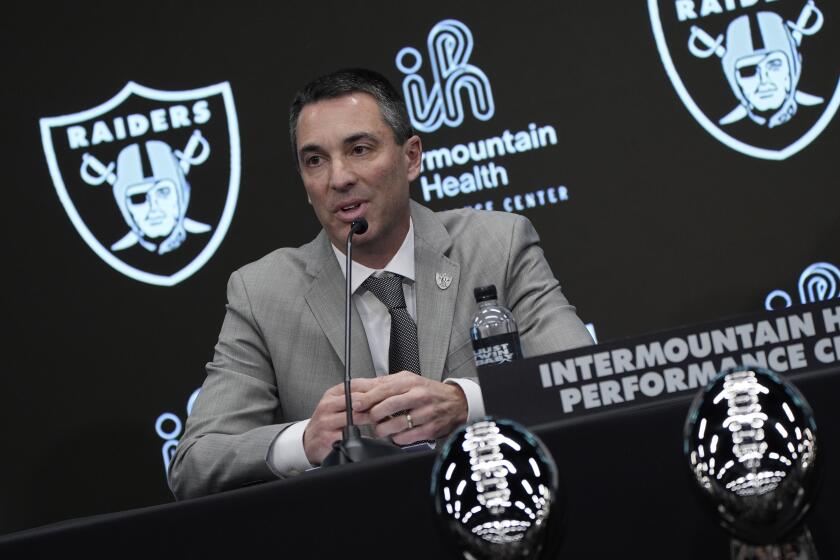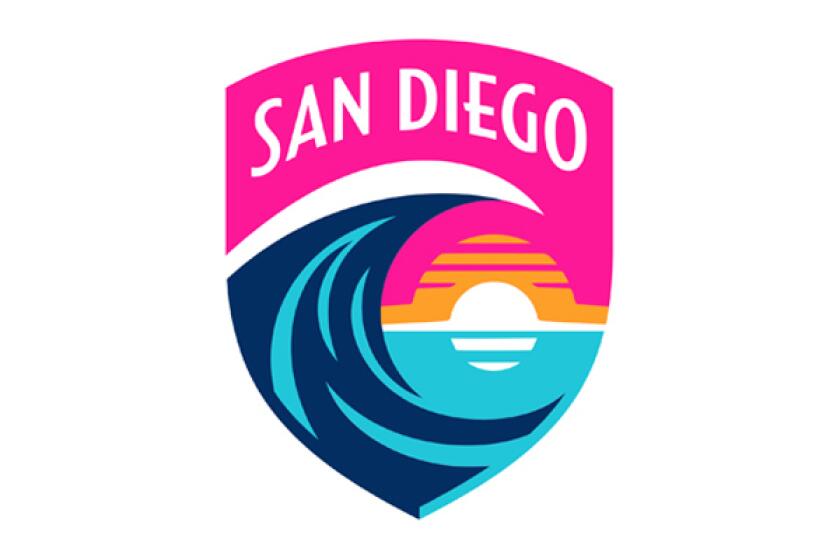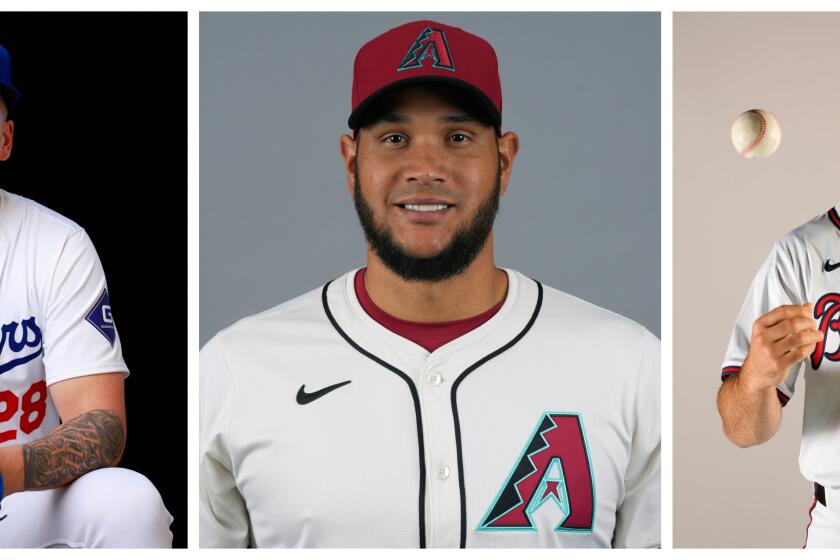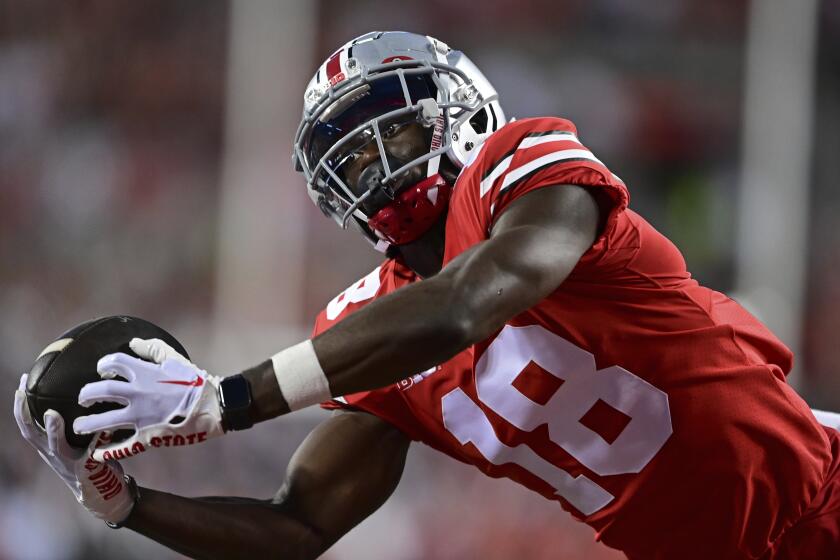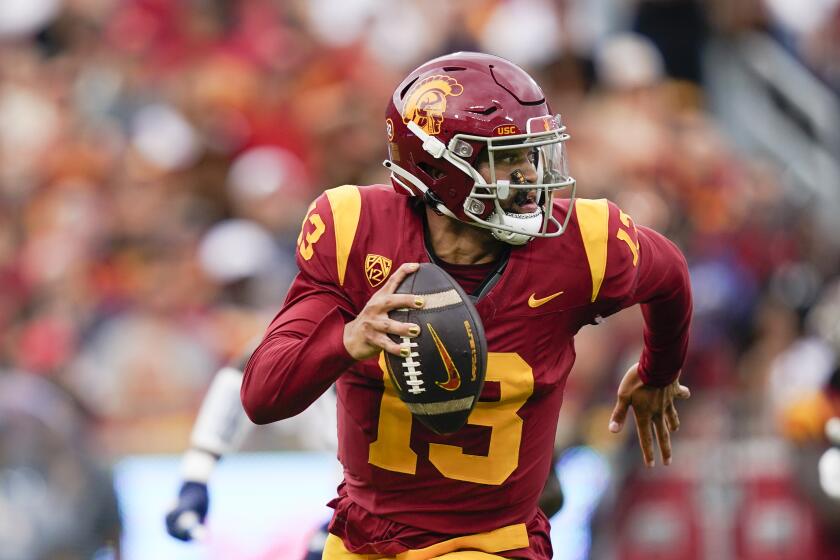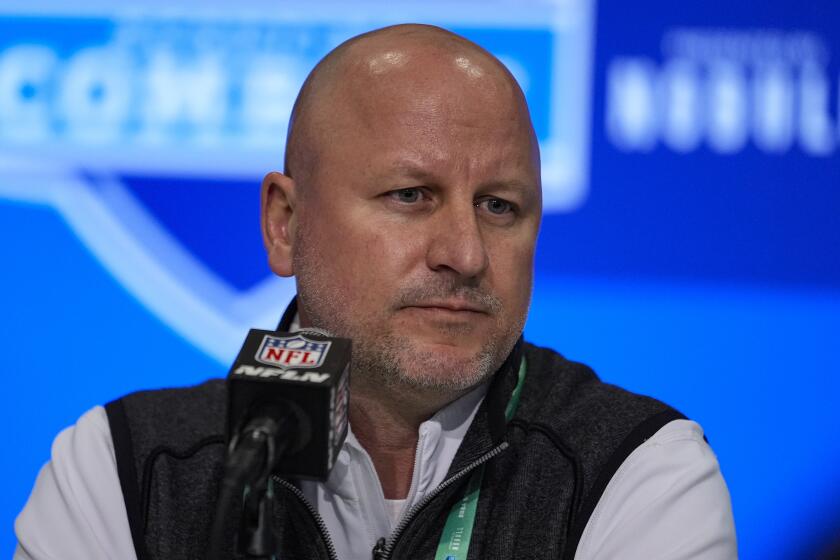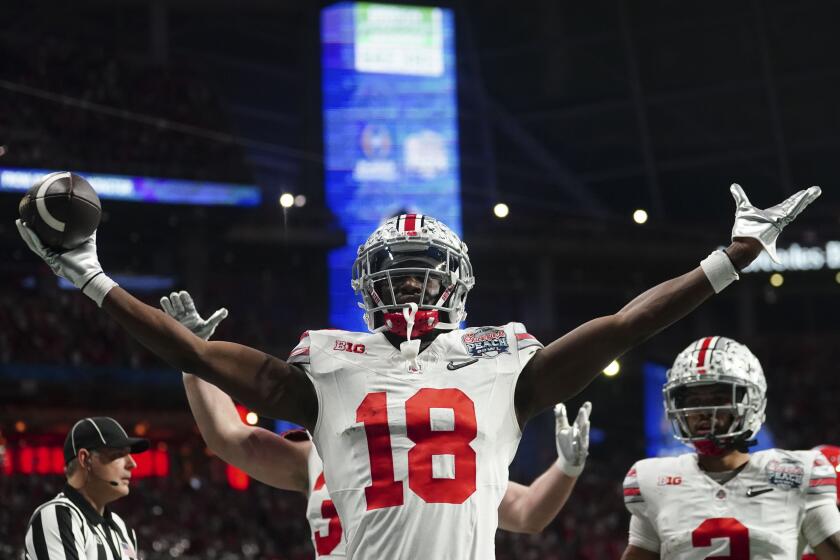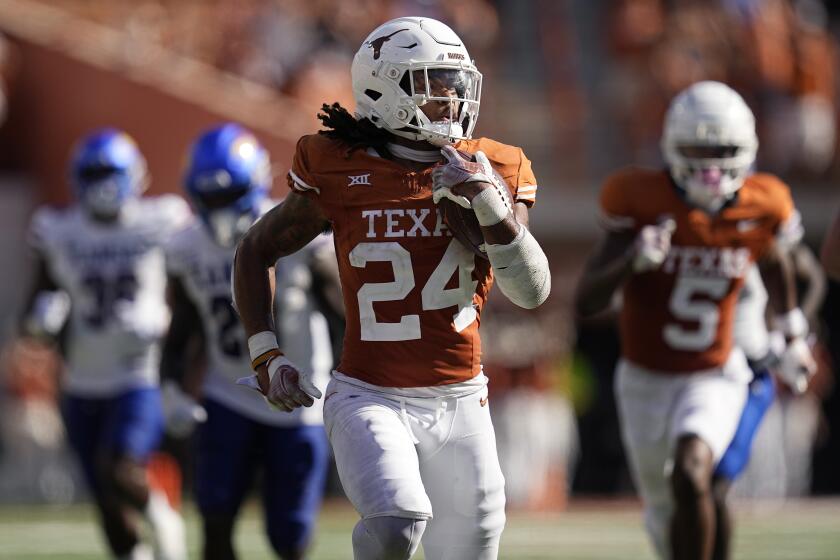Column: Rams winning ‘Fight for L.A.’ isn’t a big blow to Chargers
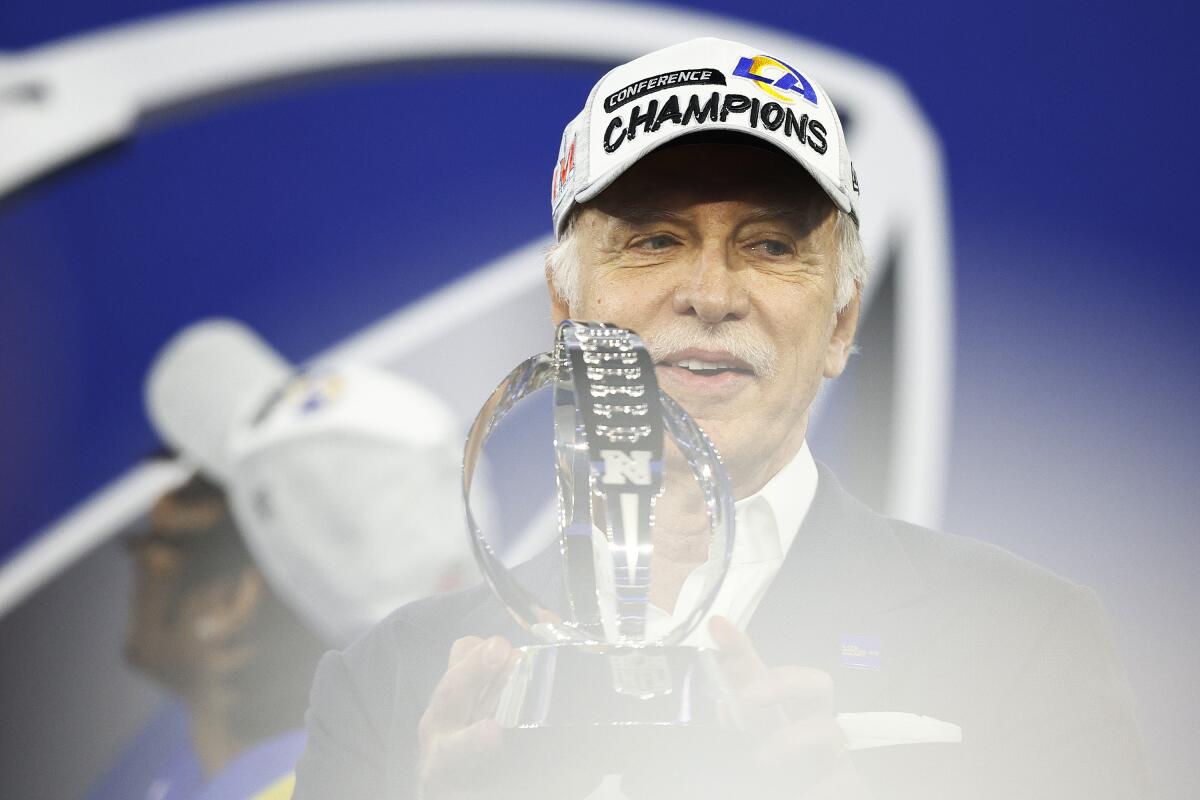
It’s not a zero-sum game between Rams and Team Spanos in ‘battle’ over nation’s second-largest market
Upon declaring their move north five years ago, the Spanos Chargers also announced a “Fight for L.A.” campaign. The image evoked wasn’t brass-knuckles — “We are committed to earning the hearts and minds of Los Angeles football fans one at a time,” said A.G. Spanos, the team’s president of business operations — but the “Fight for L.A.” slogan stuck.
Even it wasn’t really a fight, it seemed cheeky of the Spanoses to create the perception they were confronting the Rams, who had deep roots in Los Angeles.
The Rams were Chargers benefactors, not so much rivals. They’d made it possible for Dean Spanos and family to move into a new stadium. Rams owner Stan Kroenke was privately financing and overseeing the project that ultimately produced a $5.5-billion (at least) dome-like venue in Inglewood. Kroenke did the heavy lifting. The Spanoses — with a two-handed boost from the NFL — merely jumped onto Kroenke’s forklift, although not before negotiating lease terms that special counsel Mark Fabiani called “very favorable”.
If the “Fight for L.A.” schtick was just a marketing gimmick, the Rams didn’t seem in on it. When the Rams hosted an exhibition game later that summer, a musical selection treated the Chargers with kid gloves. Kindly crooning of “Why Can’t We Be Friends?” greeted Bolts personnel in pregame warmups.
On the football field, a “Fight for L.A.” hasn’t really happened. And it probably won’t, unless the teams were to meet in a Super Bowl.
Occupying different NFL conferences, the two only face each other every fourth year (a game the Rams won in 2018). If the two have competed for the same free agents, that probably hasn’t happened more than a few times.
While they might vie for the affections of the same fans to some extent, the overlap doesn’t seem highly consequential. The Rams and Chargers posted nearly identical attendance totals this past year, finishing eighth and 10th, respectively, in the 32-team NFL.
If the Chargers truly see themselves as engaged in a football fight with the Rams — which I highly doubt — the competition’s scoreboard would read something like this:
Rams 38.
Chargers 13.
The Rams are headed to their second Super Bowl in four years. The game, Feb. 13, will be played in the Kroenke Dome, only reinforcing the prevailing image that the Rams are the top NFL franchise in Los Angeles.
In comparison to that high standard, the Chargers have resembled a junior varsity program. They’ve reached the playoffs once in the five seasons and neither won an AFC West title nor played a postseason game on Greater Los Angeles soil.
If there is a fight for the hearts of Angelenos, the Rams have outdone the Chargers, but the Rams, too, have a lot of work to do there. Fans of opponents flocked to the Kroenke Dome, whether the Rams or the Chargers were the home team. It’s not a phenomenon unique to Southern California. When the defending Super Bowl-champion Tampa Bay Bucs were visited by Buffalo last month, the “Bills Mafia” in attendance produced noise that poured into the national telecast.
While a partisan crowd is preferred and might confer a small advantage for the home team, plenty of folks will buy tickets to Rams and Chargers games. The Rams, who charge higher ticket prices than their rent-free tenants do, reported an average home crowd of 71,598. For the Chargers, the reported average was 70,240.
It may take many years, perhaps decades, for both teams to build a massive fan base like the Dodgers and Lakers enjoy. The cheers of enemy fans, meantime, won’t drown the roaring cash flow of ticket revenues.
Five things
- The Rams and Chargers have differed in several aspects of team-building. The Rams have traded many more premium draft picks and acquired stars who may be perceived to have high-maintenance personalities, such as Jalen Ramsey and Odell Beckham Jr. In one core approach, Kroenke and the Spanoses are similar. They empower the football front office and the head coach nearly the same, creating checks and balances. They don’t give the head coach final say on all player personnel moves.
- On the surface, the Rams’ hire of Sean McVay was similar to the majority of the head-coach hires of the 38-year Spanos era in that McVay earned his reputation on offense and hadn’t been an NFL head coach. In addition, he hadn’t been a head coach at any level; that was true of all three Chargers head coaches — Mike McCoy, Anthony Lynn and Brandon Staley — hired since Dean Spanos fired A.J. Smith, hired Tom Telesco as GM and promoted John Spanos into the front office’s top football job. The difference is in the results. McVay has produced five winning seasons, four playoff trips and two Super Bowl berths to go with a .679 win rate. McCoy (.422) and Lynn (.516) were fired after their fourth seasons. The first season under Staley, who was McVay’s defensive coordinator in 2020, produced a 9-8 record and no playoff berth.
- Eric Weddle and the Rams made the right decision. L.A.’s Super Bowl run may have fizzled if not for coordinator Raheem Morris asking Weddle, 37, to come out of retirement and Weddle joining the defense six days before the wild-card game. Weddle played all 51 defensive snaps of L.A.’s 20-17 victory Sunday in the NFC championship game, one week after logging 61 snaps in the 30-27 victory at Tampa. He had a team-high nine tackles for a defense that held the 49ers to 50 rushing yards on 2.5 per carry. Weddle was asked to help steady a defense whose back end had unraveled in the season finale after both starting safeties went down (neither player has returned to log a snap). In the three playoff games, Rams opponents posted passer ratings of 39.1 (Kyler Murray) , 70.6 (Tom Brady) and 87.1 (Jimmy Garoppolo). Their completion rates ranged from 53.3 percent to 55.9 percent. Not having played football in some 750 days didn’t prevent Weddle from providing much-needed relief.
- Veteran NFL journalist Peter King of NBC noted Sunday it seemed unlikely to outsiders that Bengals QB Joe Burrow would be ready to start the 2021 season because the knee injury that ended his rookie season in November was so significant. Dr. David Chao was a vocal exception. Across several months, the former Chargers team physician correctly forecast a Burrow return for Week 1 and a robust comeback. What made Chao so confident? “Often there are associated injuries with an ACL tear that are not reported,” he said Monday, a day after Burrow led the Bengals to their first Super Bowl berth in 33 years. “Just because Burrow had more than an ACL (tear) reported, I felt as a quarterback he could come back strong like Philip Rivers. Of course, I felt his second half of the season would be stronger and better, which turned out to be true.”
- Safety Terrell Burgess (San Marcos High) probably will play in the Super Bowl. His 13 snaps on special teams Sunday were the most by a Rams player. L.A.’s offensive coordinator, Kevin O’Connell, also is from North County (La Costa Canyon) and later played at SDSU.



